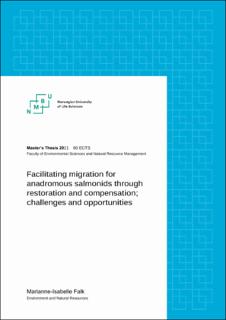| dc.description.abstract | Many of the rivers that flow into the inner part of the Oslo fjord have for a long time been subjected to habitat change done to facilitate a growing human population with all the requirements that follow. This has led to severe loss of essential habitats for spawning, nursery areas and feeding grounds for the anadromous fish populations in the fjord. Reclaiming and/or restoring areas that were barred by human activities, or making new areas available to compensate for human-induced habitat loss, is one of the goals in the new “Oslo fjord rescue plan” from the Ministry of Climate and Environment. The removal of the Bjørumssaga dam in the river Isielva and a possible fish ladder in the river Lysakerelva are good examples of ecological restoration and compensation of migration barriers, respectively. This thesis aimed to estimate smolt production for these two rivers, assess consequences the initiatives would have on the local trout population, explore the potential above the migration barriers for the anadromous species and to look at positive and negative aspects of “removing” the barriers.
Fish data was sampled using electrofishing and PIT telemetry with a portable backpack reader, and habitat characterization was done according to the a method developed by Ulrich Pulg. Population density and smolt production were based on instantaneous mortality rates and the estimated 0+ densities, as the mark-recapture data logging failed. This rendered very large instantaneous death rates, which resulted in annual mortality rates of 74 % to 80 %. Adjusted mortality rates were used to estimate the smolt production of the two rivers.
The salmon smolt production estimates based on adjusted mortality rates were very high in Lysakerelva (20.7 ind./100 m2) and high in Isielva (15.9 ind./100 m2) compared to the smolt production estimates given for the 80 National Salmon Watercourses in 2007. The trout smolt production estimates in Lysakerelva (3.3 ind./100 m2) and Isielva (1.2 ind./100 m2) were much lower. There were some indications of phenotypic differences between both the rivers and stations, both salmon and trout 0+ were in general longer in Lysakerelva than Isielva, and there were differences in length above and below migration barriers. This was especially noticeable between areas with and without salmon presence, and there was a strong indication that the presence of salmon suppressed the local trout population. Due to hatchery efforts, the smolt production potential above the migration barriers was already realised for salmon in the river stretches where the alevins/parr are released. This could be replaced by natural spawning in Lysakerelva, but not in Isielva, as the fish do not reach the migration barrier every year, and thus, would not use the stetches above this either in those years. Allowing anadromous populations past the barriers could benefit salmon sport angling, but at the cost of accessible year-round angling on local river trout. Presently, the barriers act as an insurance in case the downstream stretch becomes contaminated by pathogens or parasites like e.g. Gyrodactylus salaris, and would no longer be effective if the migration barriers were removed. | en_US |

